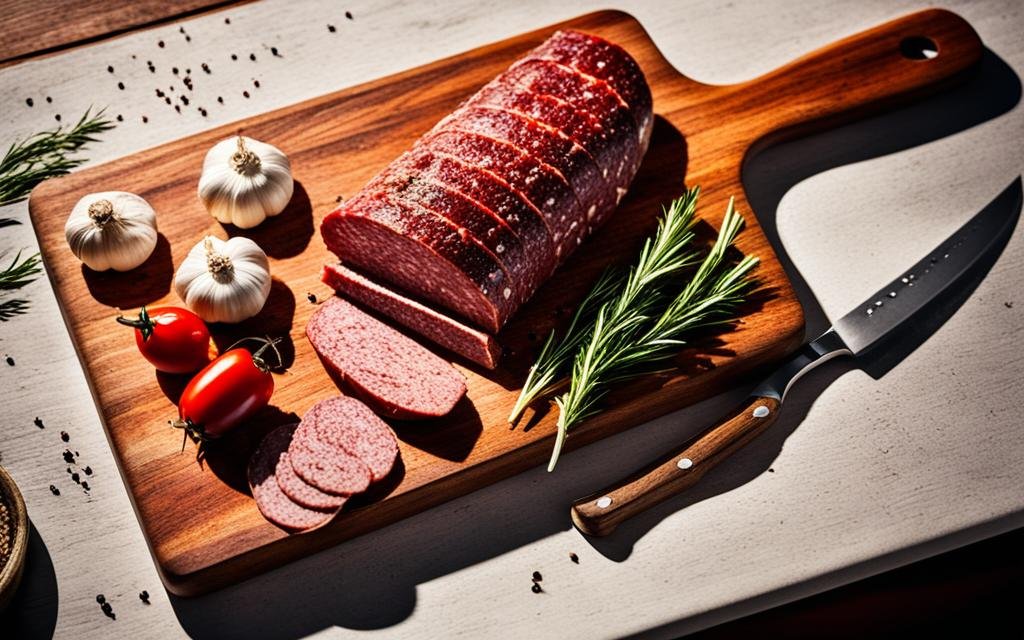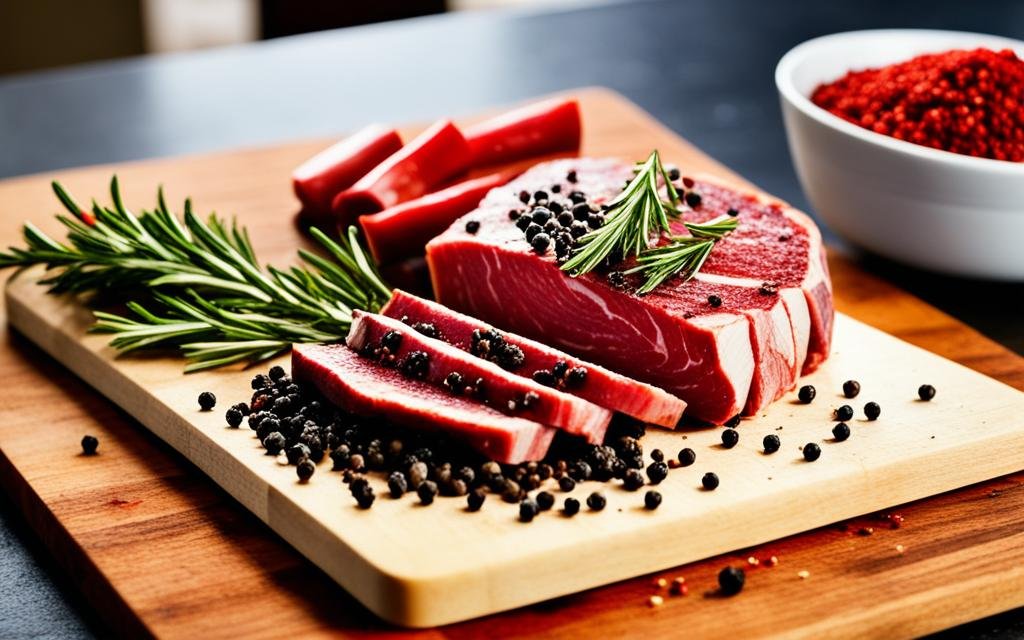The smell of curing meat takes me back to my grandmother’s kitchen in Tuscany. Her homemade Italian salami was a family treasure. It was a recipe passed down through generations. Now, I’m sharing this special recipe with you.
Making your own Italian salami at home is rewarding. You’ll enjoy mixing spices, waiting for it to cure, and looking forward to aging. The end result is a taste that beats anything you can buy.
This recipe lets you make a real Italian delicacy at home. You’ll learn how to pick the best cuts and cure them. Get ready for a tasty journey with homemade Italian dry salami recipe. These will wow your family and friends.
The Art and History of Italian Dry Salami Recipe
Italian salami has a long history that goes back centuries. It’s a key ingredient in many Italian dishes and is loved by food enthusiasts around the world.
Origins of Italian Salami
Salami making started in ancient Rome as a way to keep meat fresh. Farmers used pork, salt, and spices to make these sausages. The word “salami” comes from the Latin “salare,” which means to salt.
Regional Varieties in Italy
Italy has many types of salami, each with its own taste and tradition. Genoa salami is smooth and mild. Soppressata from the south is spicier and chunkier. Finocchiona from Tuscany is known for its fennel flavor.
Traditional Preparation Methods
Making authentic Italian dry salami recipe is an old craft. Butchers pick and grind the meat, mix it with spices, and fill it into casings. The salami cures for weeks or months, getting its special taste and texture.
Every slice of Italian salami tells a story of tradition, craftsmanship, and regional pride.
Learning about these traditions can deepen your love for Italian cooking. It also encourages you to try making salami at home. With time and effort, you can make your own Italian salami.
Essential Ingredients for Homemade Italian Salami
Creating the best Italian salami recipe starts with choosing top-notch ingredients. Using premium components makes your basic Italian salami recipe stand out. Let’s look at the key elements that make your homemade salami special.
Selecting the Right Meat Cuts
The foundation of any great salami is high-quality pork. Choose cuts with a good balance of lean meat and fat, like pork shoulder or belly. This mix ensures your salami has the right texture and flavor.
Spices and Seasonings
Spices bring life to your salami. Black pepper, garlic, and fennel seeds are staples in many Italian salami recipes. Feel free to experiment with different herb combinations to create your signature flavor.
Curing Agents and Their Importance
Curing agents are key for preserving your salami and giving it a unique taste. Salt is the main curing agent, drawing out moisture and preventing bacterial growth. Sodium nitrite, while optional, helps keep the color bright and adds protection against harmful bacteria.
A pinch of patience is the secret ingredient in every best Italian salami recipe.
The quality of your ingredients greatly affects the final product. By choosing each component carefully, you’re on your way to making an authentic Italian salami that rivals specialty shop versions.
Step-by-Step Italian Salami Recipe
Making your own dry Italian salami at home is a fun journey. This guide will help you make a tasty Italian dry salami.

Begin by picking top-notch pork shoulder and back fat. Grind the meat into a coarse texture. Then, mix it with salt, pepper, garlic, and your favorite spices. This mix is the foundation of your Italian dry salami recipes.
After that, fill the mixture into natural casings. Form the salami into links, making sure to leave air pockets. Then, prick the casing to let air out. This is key for drying and flavor.
Let your salami ferment at room temperature for 12-24 hours. This starts the curing process and gives it a tangy taste. Once fermented, move it to a cool, humid place for curing.
“Patience is key when making salami. The waiting is worth it for that perfect flavor and texture.”
Keep an eye on your salami while it cures. The best conditions are 55-65°F with 70-80% humidity. Your homemade dry Italian salami will be ready in 4-8 weeks, depending on its size and how dry you want it.
Always remember, making salami safely at home is crucial. Use clean tools and follow the right curing steps for a safe, tasty result.
Curing and Aging Your Homemade Salami
Learning how to cure and age your salami is key to making authentic Italian salami at home. This process turns raw meat into a tasty, safe treat. Let’s look at the important steps for a great cured Italian salami recipe.
Proper Curing Conditions
For dry cured Italian salami, it’s important to keep the right conditions. Store your salami in a cool, dark spot with humidity between 60-80%. A cellar or basement is often perfect. Make sure there’s good air flow to stop mold from growing.
Aging Time and Temperature
The aging time depends on your salami’s size. Smaller ones might be ready in 3-4 weeks, while bigger ones could take 2-3 months. Keep the temperature steady between 50-60°F (10-15°C) during aging. This slow aging lets the flavors fully develop.
Signs of Properly Cured Salami
Your salami is done when it loses about 30% of its weight. It should be firm and dry on the outside, with a bit of fuzzy white mold. When you slice it, the meat should be evenly colored and show fat marbling. A well-cured salami will have a rich smell and a firm feel.
“Patience is the secret ingredient in every great salami.”
By following these tips, you’ll make a tasty homemade Italian salami that’s as good as store-bought. Remember, making salami gets better with practice.
Similar Italian Recipes
Italian cuisine has many cured meat recipes, not just dry Italian salami. Let’s look at some tasty alternatives that highlight Italian charcuterie’s rich tradition.
Coppa is a type of salami made from pork neck. It’s seasoned with spices and aged for months. This version has a delicate taste and a soft texture. When you slice it thinly, it’s incredibly tender.
Pancetta is known as Italian bacon, but it’s actually cured pork belly. It’s cured with salt and spices, then rolled up. Unlike the hard salami, pancetta is cooked before eating. This adds a deep, savory flavor to many dishes.
Bresaola is a lean cured meat option. It’s made from beef eye of round, salted, and air-dried for months. The result is a deep red meat with a slightly sweet taste. It’s perfect for antipasti platters.
These recipes are different from traditional salami in how they’re made and their flavors. While salami is ground and stuffed into casings, these options use whole muscle cuts. Each brings a unique taste to the table, adding to your Italian cooking skills beyond the classic dry Italian salami recipe.
Conclusion
Making your own Italian salami at home is a rewarding journey. You’ve learned about its rich history and traditional methods. With quality ingredients and a step-by-step guide, you can make delicious salami in your kitchen.
Patience is crucial when making Italian salami. The curing and aging process takes time. But, the end result is worth it. As you get better at it, you’ll love this Italian delicacy even more. Your homemade salami will impress everyone and make you proud of your cooking skills.
Now you have the knowledge and a real Italian salami recipe to try. Get ready to make your own salami and enjoy the unique tastes you create. Happy salami making!
FAQ
What is the difference between Italian salami and other types of salami?
Italian salami is a dry-cured sausage. It’s made with pork, fat, salt, and spices like black pepper and garlic. This process gives it a unique flavor and texture. Unlike other salamis, it’s not smoked. It uses natural curing agents like salt and nitrites instead.
How long does it take to make homemade Italian salami?
Making Italian salami at home takes weeks or even months. The first steps, like grinding and mixing, take a day or two. But the curing and aging process can last from weeks to months. This is to get the right flavor and texture.
What equipment do I need to make Italian salami at home?
You’ll need a meat grinder, sausage stuffer, and a curing chamber or aging environment. You’ll also need proper casing materials like natural or fibrous casings. Sometimes, a fermentation chamber or humidor is needed for the first fermentation stage.
Is it safe to make salami at home?
Yes, making salami at home can be safe. Just follow proper food safety steps and use the right curing agents like salt and sodium nitrite. Keep the temperature, humidity, and cleanliness right to stop harmful bacteria from growing. It’s important to follow a trusted recipe and understand curing science for safety.
What are the common spices used in Italian salami?
Traditional Italian salami recipes use spices like black pepper, garlic, fennel seeds, and sometimes red wine or red wine vinegar. Some regional types might add unique spices like chili peppers, paprika, or anise or cinnamon.
How do I know when my homemade salami is fully cured and ready to eat?
Fully cured Italian salami is firm, dry, and has a deep red color. The casing should stick well to the meat, and it should smell tangy. Make sure to age it as recommended and check its weight loss. This ensures it’s cured and safe to eat.



